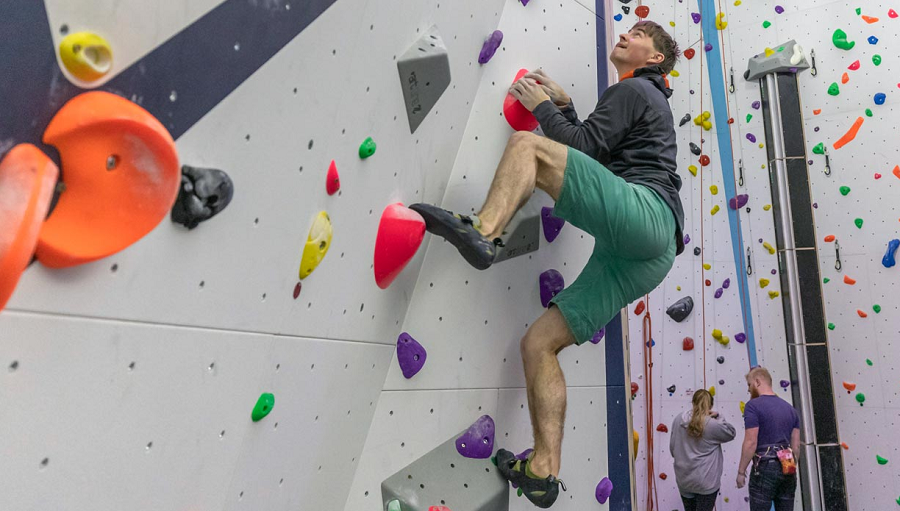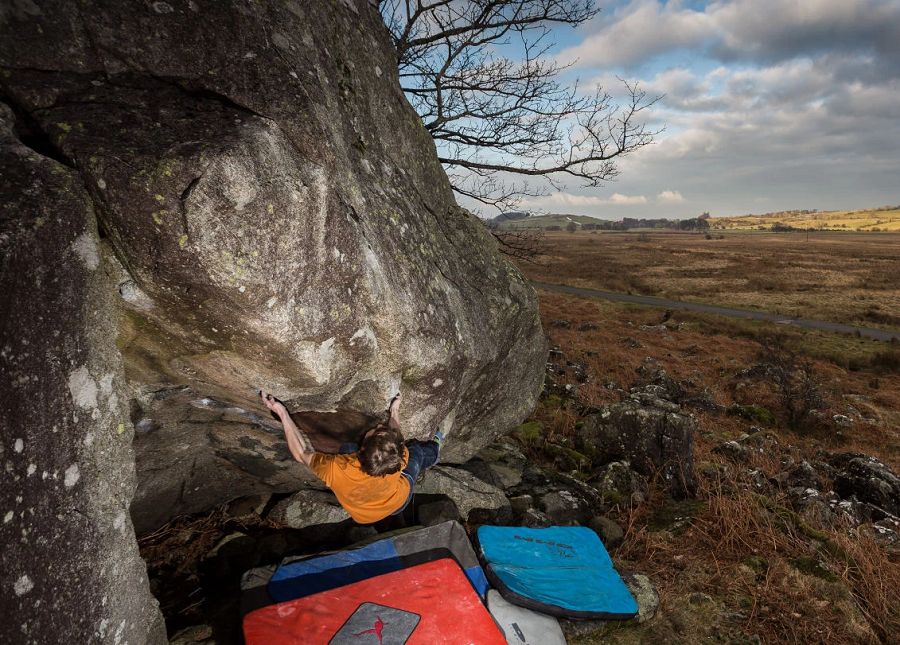
Will Nicholls, Instructor at Plas y Brenin, the National Outdoor Centre, shares his tips and advice for bouldering for beginners.
So what is bouldering?
Bouldering is a form of climbing which has gained huge popularity in recent years. It’s a fantastic way of getting into climbing as it requires little specialist kit or knowledge to get going, and, most importantly – it’s great fun! It’s also perfect for trying lots of different types of climbing and developing good technique. I personally love it because it can be a very social activity too – there’s nothing better than hanging out with a bunch of friends and doing a stack of fun boulder problems.
An indoor climbing wall, or piece of rock may have a number of ways to get to the top – these are termed problems in climbing lingo. A problem is often somewhere between two and four metres in length and can go up across. Higher boulder problems are called highballs – I’d suggest avoiding these until you’re really au fait with using bouldering pads, spotting, and managing a fall. Once you’ve reached the top of the problem it’s time to come down…

Descending the wall
You have a few options to return to the ground; sometimes the top of the boulder will be flat, with a simple walk back down – this is the easiest descent to manage. You may also be able to climb back down the route you’ve come up, as long as it isn’t too tricky. Finally, you may need to jump off, aiming for the middle of your pads for a nice soft landing.
There’s a real skill to this, and you may find yourself climbing down a few moves, then carefully jumping off. The aim is to land with equal weight on both feet and allow your legs to absorb the impact. Clearly, the higher you go, the heavier your landing, and the greater the impact on your body. Everyone has a different risk tolerance – my advice is to listen to your gut and be honest with yourself – if it’s a poor landing and the problem looks a bit too high to jump off, just climb as high as you fancy, then come back down. We’re in the business of having fun after all!
Bouldering kit for beginners
Aside from rock shoes and a chalk bag, the only other things you need are bouldering pads and spotters. In the event of falling off, a thick, cushioned matt is placed below the problem, padding out any bits of rock or obstacles. The more the merrier is all I can say! When I first started bouldering we couldn’t afford a pad, so we pretended we had one by using an old bed sheet, I don’t think it would have done much to save our ankles though…

Spotters are used in conjunction with pads – they’re just your mates. Hopefully they’ll have their eye on the ball, and should you fall off, gladly welcome you into their outstretched arms and direct you onto the pads. In essence, the higher you climb, and the less appealing the landing, the more pads and spotters you need. Indoor climbing walls have special matts already in place for this purpose.
Bouldering for beginners resources
The UK is blessed with incredible bouldering, we have everything from gritstone outcrops to seaside boulders, and problems set in the middle of the mountains. I’d suggest getting a copy of Boulder Britain by Niall Grimes for an overview of what the UK has to offer. Obviously, I have to say I believe North Wales is the best place in the country for bouldering! We have everything I’ve just listed above – and more!

Pete Edwards, a very keen and passionate boulderer who used to work in our stores would sign the North Wales Bouldering guide out, noting it simply as The Bible! This is an amazing resource which I’d thoroughly recommend getting a copy of. Guidebooks are a fantastic resource, but it’s also worth knowing that not all boulder problems are in guides – if you see something you fancy climbing, get stuck in!
Related article: climbing and bouldering documentaries to inspire your next advenure!
Hopefully this has given a flavour of what it’s about and why bouldering is ace! I’ll conclude with a few bouldering for beginners top tips;
- Boulder with lots of pads and spotters.
- If you can, check what the top of the problem is like by sneaking round the side – sometimes you’ll spot an elusive and essential handhold.
- Clean your rock shoes on a towel before stepping on the rock – there’s nothing worse than pinging off from the last hold because there’s mud on your toe!
- Don’t worry too much about grades – I’ve seen incredible climbers get shut down on problems with low grades.
- It can be hard on your body – warm up gradually and leave steep, fingery problems till you’re ready.
- You can gain lots of mileage by bouldering and develop excellent technique – this is money in the bank for future climbing.
- Have a balanced bouldering diet – mix up slabs, corners, aretes, overhangs and cracks and different rock types.
- Have a blast!
Plas y Brenin
Plas y Brenin, the National Outdoor Centre is nestled in the heart of Snowdonia, with easy access to world class bouldering and traditional climbing. We simply love climbing and helping others achieve their potential. Follow on Instagram and Facebook for more outdoor inspiration or to find out more about the epic adventure days.